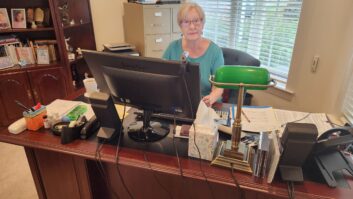New York State Broadcasters Association President David Donovan spoke with Radio World’s Emily Reigart Wednesday about regional radio and TV efforts surrounding Hurricane Sandy.
What is your general overview of broadcasters’ work in the storm?
I think it was best summed up by one broadcast engineer who noted that, essentially, the only communications that seemed to be working in Lower Manhattan were off-air radio and television. Everything else was out. Your cellphones were out. Your cable was out. Your power was out. A lot of your landline phones were out.
It was the local New York broadcasters, both TV and radio, that essentially served the vital function of connecting public officials to the community. Essentially, we’re first informers. What it comes down to for us often is allowing the first responders to connect to the community and the community to hear what the first responders have to say.

I don’t think people realize what a phenomenal job the broadcast industry did here. Talk about the proverbial candle in the window. They were the only thing working in Lower Manhattan.
You have members throughout the state but who was hardest hit?
New York City and Long Island were hardest hit. For the AM stations that went off air, most shifted their AM news functions to their sister stations in the FM band.
For example, WINS 1010 shifted its news operations first to WCBS, which is 101.1 then later to WXRK 92.3. WNYC Public Radio shifted its news function [from AM] to WNYC(FM). WEPN(AM) and WEPN(FM) simulcast the storm coverage that came from ABC. Many stations that have entertainment formats shifted to news.
On Long Island it is my understanding right now [Wednesday afternoon] that they all stayed on the air except WALK(FM), which began to operate from a Suffolk County emergency management center, but their AM remained operational. WLNG(FM) up in Sag Harbor was off for a little while but, but was back on the air by Tuesday.
During the storm was there ever a total loss of broadcast?
To the best of my knowledge, all television stations remained on the air, none of them went out. Some TV stations even provided radio simulcasts. There were a couple AM stations that went off the air, largely due to the flooding in the Meadowlands. WOR(AM) was a notable exception and remained on the air fulltime.
Is there a lesson there?
Local broadcasting is far more robust and redundant than people realize. You can lose one AM station and shift the content to an FM station so consumers can still access life-saving information. Also, there are things that make broadcast work during emergencies.
One is the way that the system is designed, which is what we call a one-to-many multipoint system. Whether one person or two people or 2 million people receive that signal, it doesn’t get overburdened. But during emergencies your cellular telephone network gets overwhelmed, which makes broadcasting a far better system.
You also have to remember unlike other systems, most of your major broadcasters have backup generators. As long as you can get fuel to these things, you can operate for a long time.
What are some of the takeaways from this event?
The flooding hit hard. That required a lot of quick thinking on the part of the engineers and that’s one of the things we’ll have to look at going forward. I think they should be congratulated for doing an unbelievable job in absolutely horrific circumstances.
I think it’s important after any disaster for the engineers to sit down, assess what went right and what went wrong and improve. Obviously there were facilities in the Meadowlands in New Jersey where the water just really came in, and they have to think about that in the event of another disaster. Even though they were heavily flooded, what you saw were station managers and engineers thinking very quickly of alternate ways to keep those signals on the air.
I’m proud to say that even though stations are competing with each other on a regular basis, day-to-day, during emergencies they get incredibly cooperative. The engineers work together, the reporters work together with the goal of making sure that no information is lost.
Tell Radio World about your station or company experience with Sandy. Email [email protected] (our emergency email contact until our regular email service can be restored).
David Donovan took his post with NYSBA in 2011. He is former president of trade association MSTV; past positions include vice president of legal and legislative affairs for the Association of Local Television Stations. He worked in several positions at the FCC and was media advisor to former Commissioner James Quello.












